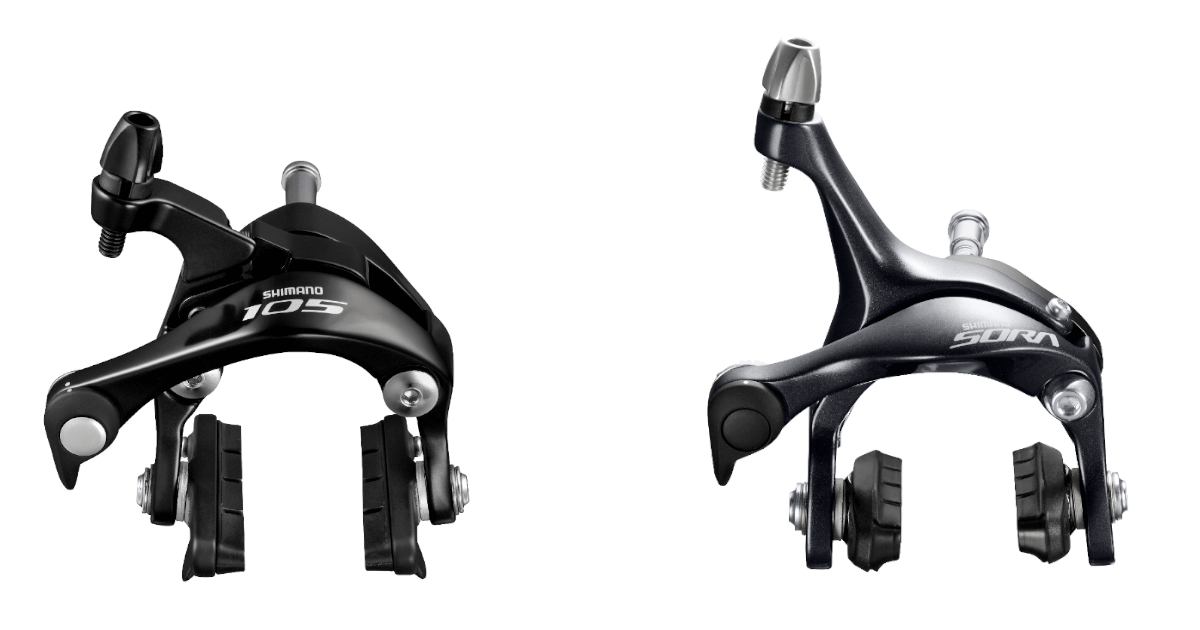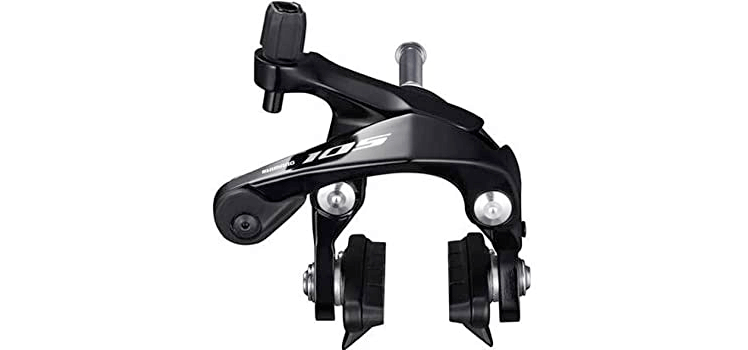Overview and Specifications of WheelTop's Affordable Electronic Groupset "EDS"
This article summarizes the features and specifications of the budget-friendly electronic groupset "EDS" newly released by the Chinese manufacturer WheelTop.
Posted at: Mar 19, 2021
Which is better, Shimano's older generation higher grade brakes or the current lower grade brakes? This article examines Shimano's brake technology and the year they were released.

Table of contents
Sponsored Link
First, let’s check out the technology used in Shimano’s brakes of the past.

Shimano’s latest brake technology is this SLR-EV. It is a conventional dual-pivot system, but with three fulcrum points for increased rigidity. The amount of pull on the brake lever is compatible with the NEW SUPER SLR.
The NEW SUPER SLR is an evolved version of the SUPER SLR, and when combined with the corresponding STI lever, it can provide strong braking power even with weak force.
It is different from the SLR-EV mentioned above, but the amount of brake lever pull is compatible with the SLR-EV.
This is the generation of Shimano’s dual-pivot brakes, often referred to as the old SUPER SLR because it is easily confused with the NEW SUPER SLR.
It requires more grip strength when braking than the NEW SUPER SLR.
Let’s take a look at each grade of road bike and see which brakes use each technology.
| Grades | SLR-EV | NEW SUPER SLR | OLD SUPER SLR |
|---|---|---|---|
| DURA-ACE | BR-9000 or later | BR-7900 | BR-7800 or earlier |
| ULTEGRA | BR-6800 or later | BR-6700 | BR-6600 or earlier |
| 105 | BR-5800 or later | BR-5700 | BR-5600 or earlier |
| TIAGRA | - | BR-4600 or later | BR-4500 |
| SORA | - | BR-3500 or later | BR-3400 |
| SORA | - | BR-3500 or later | BR-3400 |
As of January 2021, only brakes of the 105 grade and above are compatible with the latest technology, SLR-EV; all brakes below TIAGRA, even the latest ones, stop at NEW SUPER SLR.
Although 105 is race-ready and preferred by hobby racers, it has been compatible with SLR-EV since the previous generation BR-5800, so this may be the reason why “if you are going to upgrade, at least go with 105”.
Next, let’s take a look at the current generation of Shimano brakes for road bikes and which technologies they use.
| Grades | SLR-EV | NEW SUPER SLR | 旧SUPER SLR |
|---|---|---|---|
| DURA-ACE | BR-R9000 | - | - |
| ULTEGRA | BR-R8000 | - | - |
| 105 | BR-R7000 | - | - |
| TIAGRA | - | BR-4700 | - |
| SORA | - | BR-R3000 | - |
| CLARIS | - | BR-R2000 | - |
Shimano’s current generation of brakes are all NEW SUPER SLR or higher.
The 105 and above are the latest technology “SLR-EV”, but all other grades are NEW SUPER SLR. In this sense, we can say that the technology is “105 and above, and the rest”.
When buying brakes at a second-hand store, the question that comes to mind is: “older generation higher grade vs. current generation mid-range or lower grade”? That’s the question, isn’t it?
Let’s compare the current generation mid-grade and lower-grade brakes with the older generation upper-grade brakes.
First of all, the following is a comparison between the higher grade of one generation ago and the current grade.
| Grades | SLR-EV | NEW SUPER SLR | 旧SUPER SLR |
|---|---|---|---|
| DURA-ACE | BR-9000 | - | - |
| ULTEGRA | BR-6800 | - | - |
| 105 | BR-5800 | - | - |
| TIAGRA | - | BR-4700 | - |
| SORA | - | BR-R3000 | - |
| CLARIS | - | BR-R2000 | - |
The 105 and above are already SLR-EV one generation before the current R generation, so even the older models are better brakes than the middle and lower grade brakes of the current generation.
If you don’t consider the condition of the parts, then a used 105 or higher brakes of the previous generation is a better buy than a new lower grade of the current generation.
So how does it compare to the brakes of the higher grade two generations ago?
| Grades | SLR-EV | NEW SUPER SLR | 旧SUPER SLR |
|---|---|---|---|
| DURA-ACE | - | BR-7900 | - |
| ULTEGRA | - | BR-6700 | - |
| 105 | - | BR-5700 | - |
| TIAGRA | - | BR-4700 | - |
| SORA | - | BR-R3000 | - |
| CLARIS | - | BR-R2000 | - |
All are now NEW SUPER SLR. In other words, the current generation of mid- and lower-grade brakes can be viewed as “equivalent to the brakes two generations before the higher grade” in terms of technology.
Incidentally, the current generation of mid- and lower-grade brakes were released between 2015 and 2017, while the brakes two generations before the higher-grade brakes are products that were released between 2008 and 2010.
Considering the deterioration of the parts, it would be better to buy the current generation mid- and lower-grade brakes with equivalent technology than to buy brakes that are more than 10 years old.
I’ve been looking at the older generation of Shimano’s higher grade brakes and whether the current lower grade brakes are better.
In summary, here’s what we’ve learned
When you want to replace or upgrade your brakes, it is quite difficult to decide which parts to choose, but if you look at it from the perspective of the technology installed, it will be easier to choose.
Sponsored Link
Types and Differences of Brakes for Sports Bicycles
Sports bicycles are equipped with various types of brakes. Here is a summary of each brake, its features and differences, advantages and disadvantages, and which brake bike you should buy in the future.
How to lighten heavy mechanical brakes.
The weight of the brakes not only affects the braking power, but also creates a significant impact on fatigue during the ride. In this article, we'll take a look at how mechanical brakes work and how you can lighten the weight of heavy brakes.
Selecting Shimano Brakes for Road Bikes: A Summary of Model Numbers
Brakes are an important part of a road bike that is responsible for braking. In this article, we will discuss how to select Shimano brakes for road bikes, which are of high quality and highly available in Japan, and summarize the model numbers of each grade of brake.
The higher the grade, the better it works! Brake shoe types and interchangeability
Of all the bicycle parts, brake shoes are the most frequently replaced along with tires and tubes. The following is a summary of the types of brake shoes and notes on compatibility, which are said to work better if they are used at the top level.
Shimano's older high-grade brakes vs. current lower-grade brakes: Which is better?
Which is better, Shimano's older generation higher grade brakes or the current lower grade brakes? This article examines Shimano's brake technology and the year they were released.
Road Bike to Disc Brakes Conversion: Parts Needed and Buying Tips
Disc brake-equipped road bikes have been on the rise in the past few years. "For those who want to try out disc brakes but don't want to buy a new bike, we've put together a list of the parts you'll need to buy disc brakes and the points to keep in mind when buying.
Differences and Identification of Disc Brake Only Wheels
Disc brake bicycles require wheels specially designed for disc brakes. In this article, we will discuss what is the difference between disc brake-specific wheels and rim brake-specific wheels. What is the difference between a disc brake wheel and a rim brake wheel? Or rim brake only? When selecting a wheel, it is important to know how to tell the difference.
Should I use disc brakes or rim brakes?
Disc brakes are coming of age, and conventional rim brakes such as caliper brakes and V-brakes. This article summarizes the differences between them and which is better.
Overview and Specifications of WheelTop's Affordable Electronic Groupset "EDS"
This article summarizes the features and specifications of the budget-friendly electronic groupset "EDS" newly released by the Chinese manufacturer WheelTop.
What Is Shimano Shadow RD? Features and Benefits
What is Shimano’s Shadow RD used in their latest rear derailleurs? This article explains its features and the benefits of choosing Shadow RD.
[MTB / Hybrid Bike] Hydraulic Brake Manufacturers for Flat Bars
An overview of manufacturers that produce hydraulic brakes for flat-bar MTB and hybrid bikes, along with their key features. Also includes tips on how to choose the right flat-bar hydraulic brake brand.
Shimano Chain Compatibility for Road, MTB, and Hybrid Bikes
An overview of Shimano chain compatibility across road bikes, mountain bikes, and hybrid bikes. Includes guidance on how to choose the right chain for your drivetrain.
Shimano ESSA Lineup and Compatibility with Existing 8-Speed Parts
An overview of Shimano's newly released 8-speed component group "ESSA" and its compatibility with existing 8-speed parts.
SRAM Cassette Compatibility Guide
Compatibility guide for SRAM cassettes used in road and MTB bikes. Find matching drivetrains and wheels easily.
Compatibility Guide for SRAM MTB Components
A detailed explanation of compatibility between SRAM MTB components. This guide outlines which parts can be used together and which combinations are not compatible.
Road and MTB Sprockets Compatibility Overview
A guide to the compatibility between road and MTB sprockets, explaining whether they can be used together with different components.
Types of Shimano Di2 Tools and Their Compatibility
A guide to the essential Shimano Di2-specific tools, especially the "plug tools" used for connecting components, and their compatibility with various Di2 parts.
Shimano CUES Cassette Compatibility Guide
A detailed guide to the compatibility of Shimano CUES series cassettes. Includes an overview of compatible rear derailleurs, chains, and wheels.
Shimano Hydraulic Brake Hose and Connector Standards Guide
An explanation of the differences between Shimano’s hydraulic brake hoses BH90 and BH59, the types of connecting bolts, and how to choose the right hose for your brake system—including key points to watch out for.
[By Manufacturer] Types, Features, Pros and Cons of Hydraulic Brake Oils
This article explains the types of hydraulic oils used in bicycle hydraulic brakes, their characteristics, and the brake oil types used by each manufacturer.
Types and Compatibility of Shimano Di2 Batteries
The Di2 battery is the core of the Shimano Di2 system, influencing the overall system layout. This article explains the different types and their compatibility.
Shimano Di2 Wire Types and Compatibility
Overview of Shimano Di2 electric wire types and their compatibility with Di2 components.
How to Identify Shimano Di2 Generations
Explains the generational differences in Shimano Di2 components and their compatibility. Includes a list of component series and their corresponding generations.
In-Depth Guide to Shimano 12-Speed Cassette Compatibility
A detailed explanation of the key compatibility factors when using Shimano's 12-speed cassettes—specifically the required wheel (freehub) and drivetrain, which differ significantly from previous 11-speed systems.
Perfect Guide to Shimano 11-Speed Cassette Compatibility
A detailed explanation of two key compatibility factors when using Shimano 11-speed cassettes: the required wheel (freehub) and drivetrain.
Perfect Guide to Shimano 10-Speed Cassette Compatibility
A detailed explanation of two key compatibility factors when using Shimano 10-speed cassettes: the required wheel (freehub) and drivetrain.
In-Depth Guide to Shimano 9-Speed Cassette Compatibility
A comprehensive explanation of two key compatibility factors when using Shimano 9-speed cassettes: the required wheel (freehub) and drivetrain.
What Is a BOOST Crank? Differences from Standard MTB Cranks and How to Choose
This article explains what a BOOST crank is, how it differs from conventional MTB cranks, and provides guidance on selection across different manufacturers.